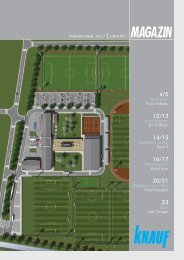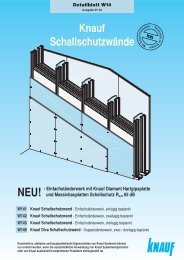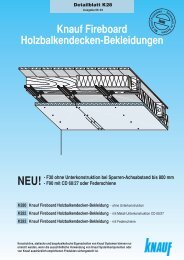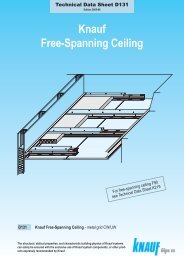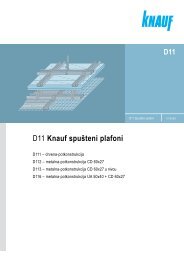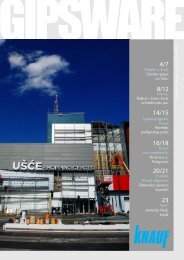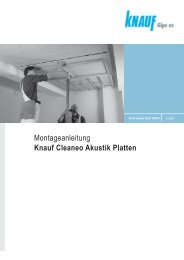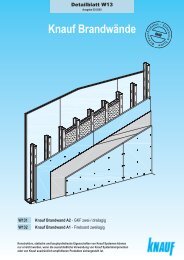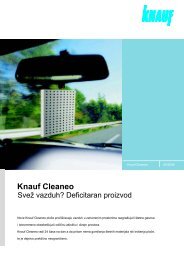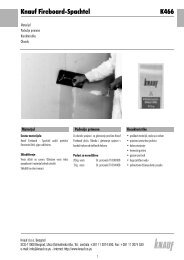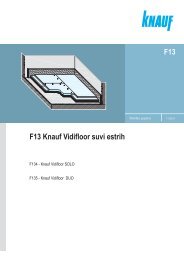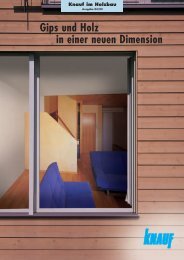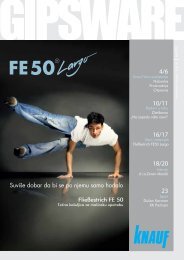Knauf Seismic Design
Knauf Seismic Design
Knauf Seismic Design
You also want an ePaper? Increase the reach of your titles
YUMPU automatically turns print PDFs into web optimized ePapers that Google loves.
The main advantages of <strong>Knauf</strong> nonload<br />
bearing partitions are the reduction<br />
of construction weight (see table 3, page<br />
7 and table 4) and the ductile behavior of<br />
deformation. The dead load decrease of<br />
non-load bearing construction components<br />
leads to a massive reduction of loads in the<br />
event of an earthquake.<br />
The most ideal application of <strong>Knauf</strong><br />
partitions in connection with earthquake<br />
safety is their use as infi ll walls for skeleton<br />
constructions.<br />
The brittle and comparatively rigid<br />
deformation behavioral patterns of the<br />
infi ll masonry used generally causes load<br />
transfer with dangerous, explosion-like and<br />
<strong>Knauf</strong> <strong>Seismic</strong> <strong>Design</strong><br />
Non-load bearing<br />
Partitions<br />
Table 4: Weight comparison of infill masonry and <strong>Knauf</strong> Drywall Systems W111/ W112<br />
Weight Reduction<br />
1 m² masonry d = 11.5 cm;<br />
Weight per unit area: approx. 145 kg/m²<br />
1 m² metal stud partition, single layer;<br />
Weight per unit area: approx. 25 kg/m²<br />
1 m² metal stud partition, double layer;<br />
Weight per unit area: approx. 50 kg/m²<br />
→ Weight reduction by 65 % to 83 %<br />
unannounced collapse that can even lead<br />
Table 5: Stress resultants from lateral horizontal loads<br />
System<br />
W111<br />
d = 100 mm<br />
W112<br />
d = 125 mm<br />
Horizontal<br />
acceleration<br />
0.5 g<br />
(4.9 m/s²)<br />
Max.<br />
shift<br />
[mm]<br />
Maximum<br />
bending<br />
moment<br />
[kNm]<br />
2.5 - 14 0.1 - 0.3 2.0<br />
11.6 - 25 0.3 - 0.6 2.6<br />
Bending<br />
moment<br />
capacity<br />
[kNm]<br />
to the total collapse of the whole building.<br />
Even when highly deformed, drywall<br />
partitions maintain their enclosing function<br />
and do not collapse completely. [7]<br />
According to the “Report of Earthquake<br />
Proof Execution of Partitions and Suspended<br />
Ceilings” by Dr. Rainer Flesch of the<br />
“Bundesforschungs- und Prüfzentrum Arsenal”<br />
(Federal Research and Test Centre<br />
Arsenal) [6], <strong>Knauf</strong> metal stud partitions<br />
can effectively resist and absorb lateral<br />
loads caused by earthquake acceleration<br />
and their own weight.<br />
Table 5 shows calculated stress resultants<br />
for a lateral horizontal acceleration of<br />
2.5 m h 3.5 m<br />
U ; V´<br />
0.5 g on <strong>Knauf</strong> partitions W111 and W112.<br />
2.5 m l 15.0 m<br />
Figure 13: Lateral horizontal loading<br />
10



